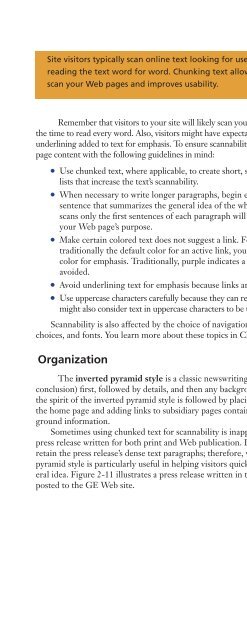(Shelly Cashman Series) Gary B. Shelly, H. Albert Napier, Ollie N. Rivers-Web design_ introductory concepts and techniques -Cengage Learning (2008)
You also want an ePaper? Increase the reach of your titles
YUMPU automatically turns print PDFs into web optimized ePapers that Google loves.
Writing for the <strong>Web</strong> 51<br />
Site visitors typically scan online text looking for useful information instead of<br />
reading the text word for word. Chunking text allows your site visitors to quickly<br />
scan your <strong>Web</strong> pages <strong>and</strong> improves usability.<br />
DESIGN<br />
TIP<br />
Remember that visitors to your site will likely scan your <strong>Web</strong> pages rather than taking<br />
the time to read every word. Also, visitors might have expectations for the use of color <strong>and</strong><br />
underlining added to text for emphasis. To ensure scannability, you should write your <strong>Web</strong><br />
page content with the following guidelines in mind:<br />
• Use chunked text, where applicable, to create short, succinct paragraphs <strong>and</strong> bulleted<br />
lists that increase the text’s scannability.<br />
• When necessary to write longer paragraphs, begin each paragraph with a topic<br />
sentence that summarizes the general idea of the whole paragraph. A visitor who<br />
scans only the first sentences of each paragraph will still get the overall picture of<br />
your <strong>Web</strong> page’s purpose.<br />
• Make certain colored text does not suggest a link. For example, because blue is<br />
traditionally the default color for an active link, you should avoid using the blue<br />
color for emphasis. Traditionally, purple indicates a visited link <strong>and</strong> also should be<br />
avoided.<br />
• Avoid underlining text for emphasis because links are traditionally underlined.<br />
• Use uppercase characters carefully because they can reduce scannability. Some visitors<br />
might also consider text in uppercase characters to be the equivalent of shouting.<br />
Scannability is also affected by the choice of navigational elements, color scheme<br />
choices, <strong>and</strong> fonts. You learn more about these topics in Chapters 4 <strong>and</strong> 5.<br />
@SOURCE<br />
Writing for the <strong>Web</strong><br />
For more information<br />
about writing easily<br />
readable <strong>Web</strong> content,<br />
visit the <strong>Web</strong> Design<br />
Chapter 2 Online<br />
Companion page<br />
(scsite.com/web3e/ch2/)<br />
<strong>and</strong> then click Writing<br />
for the <strong>Web</strong> in the<br />
@Source links.<br />
Organization<br />
The inverted pyramid style is a classic newswriting style that places a summary (or<br />
conclusion) first, followed by details, <strong>and</strong> then any background information. On the <strong>Web</strong>,<br />
the spirit of the inverted pyramid style is followed by placing summary chunked text on<br />
the home page <strong>and</strong> adding links to subsidiary pages containing related details <strong>and</strong> background<br />
information.<br />
Sometimes using chunked text for scannability is inappropriate; for example, for a<br />
press release written for both print <strong>and</strong> <strong>Web</strong> publication. In this example, it is necessary to<br />
retain the press release’s dense text paragraphs; therefore, writing the text in the inverted<br />
pyramid style is particularly useful in helping visitors quickly underst<strong>and</strong> the text’s general<br />
idea. Figure 2-11 illustrates a press release written in the inverted pyramid style <strong>and</strong><br />
posted to the GE <strong>Web</strong> site.


